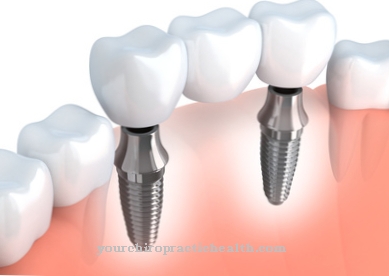Dental implants are artificially produced tooth roots. They are reminiscent of the shape of a dowel and are inserted directly into toothless sections of the jawbone. A neck part on which an implant crown is placed is located above this anchored implant body.
What are dental implants?

The function of the dowel-shaped implant is to be able to grow into the living tissue of the jawbone and then to hold a tooth crown firmly in the mouth. This connection must be so stable that it can withstand the stress of chewing.
The material of the implant must therefore be biocompatible. This is the only way to ensure that the body does not develop any defense reactions. Implants therefore have a healing time of at least three months after insertion. Then they are firmly attached to the bone. Living bone cells grow to the surface of the implant body.
If the stability of the implant is guaranteed, the implant crown can be placed. This artificial tooth crown is screwed or cemented onto the neck part. The neck part of an implant is particularly smooth. It is located at the point of passage to the oral mucosa and should therefore be particularly easy to clean. The jawbone is protected because bacteria cannot penetrate from the oral cavity. The smoothness of the neck part is also a protection against inflammation.
The three-part structure of an implant consisting of the implant body, neck part and implant crown is also referred to as endosseous. This type of implant is used almost exclusively.
Shapes, types & types
There are now many different implant systems. The systems have in common that they are all anchored in the jawbone by a screw shape, cylinder shape or root shape. The design is different. There are also differences in the way the neck part and the artificial dentures to be attached are brought together. The surfaces of the implants can also have different designs.
With a modern implant system, practically every tooth in the dentition can be replaced. Since a dental implant looks very natural and like a real tooth, it is particularly important in the anterior region.
A dental implant is always a nature-identical denture. The materials from which a dental implant is made must meet the highest demands in terms of biocompatibility and strength. Therefore, implants are mainly made from titanium alloys or pure titanium. Titanium is a metal that is accepted by the body without any rejection or allergic reactions. Alternatively, there are also implants made of special ceramic material. However, these ceramic implants are much more prone to breakage than metal implants.
The aim of every implant is osseointegration. This is understood to mean the accumulation of bone tissue on the load-bearing implant. Compared to a natural tooth, an implant has a different biomechanical situation. The artificial tooth abutment has direct bone contact. The protective layer of connective tissue is missing. This means that there is no mobility between the bone and the implant, which leads to better relief in a healthy tooth.
During the healing process, comparisons have shown that the additively or subtractively conditioned surfaces in implants have a better microstructure than the mechanically smooth implant bodies. Most systems have subtracting conditioned surfaces. These surfaces are removed by etching, radiation or oxidation. This results in clearly positive results in long-term clinical studies with successful osseointegration.
Structure & functionality
Despite the many different manufacturers and implant systems, the basic structure of a dental implant is always the same. Every dental implant consists of several components. This always includes the implant body as the basis. It is the artificial tooth root, which offers strength and stability after the required healing time. Every treatment with a dental implant therefore begins with an appropriate drilling into the jawbone in order to create a sleeve into which the implant body can be inserted.
So that this dowel-like shape can also grow in well, the surface is provided with a special structure, etched or roughened. As an alternative to titanium there is the ceramic zirconium oxide as an implant body.
The implants are helical or cylindrical. They are available in different diameters and lengths. The size of a dental implant depends on the area of application, the tooth gap to be filled and the function of the tooth gap in the dentition.
The connecting part between the implant body and the crown is the neck part of the implant, also called the crown structure. Its function is to create enough space between the gums and the visible part of the implant. It also serves the purpose of a link. The visible tooth crown is placed on the crown abutment. When fully installed, a dental implant replaces a natural tooth and is similarly resilient.
You can find your medication here
➔ Toothache medicationMedical & health benefits
Dental implants can be of great benefit to patients whose chewing ability is limited by lost teeth. In some cases, they also offer advantages over dental bridges. If, for example, a single tooth gap is replaced, neighboring teeth no longer have to be ground down. Furthermore, the disruptive brackets that damage the neighboring teeth are no longer necessary. Compared to removable dentures, implants are also much more stable and optimally support the chewing function. Dental implants give a patient a better quality of life for everyday life.
Pressure points and the associated complaints are also avoided. Dental implants complete incomplete teeth. They can hardly be distinguished from natural teeth in terms of appearance. In this way, they also meet the aesthetic requirements for beautiful teeth.
Nevertheless, such an intervention in the body should not be underestimated. Inflammation may occur, the bones may not heal properly, or people may be sensitive to the foreign body in their mouth.

























.jpg)


